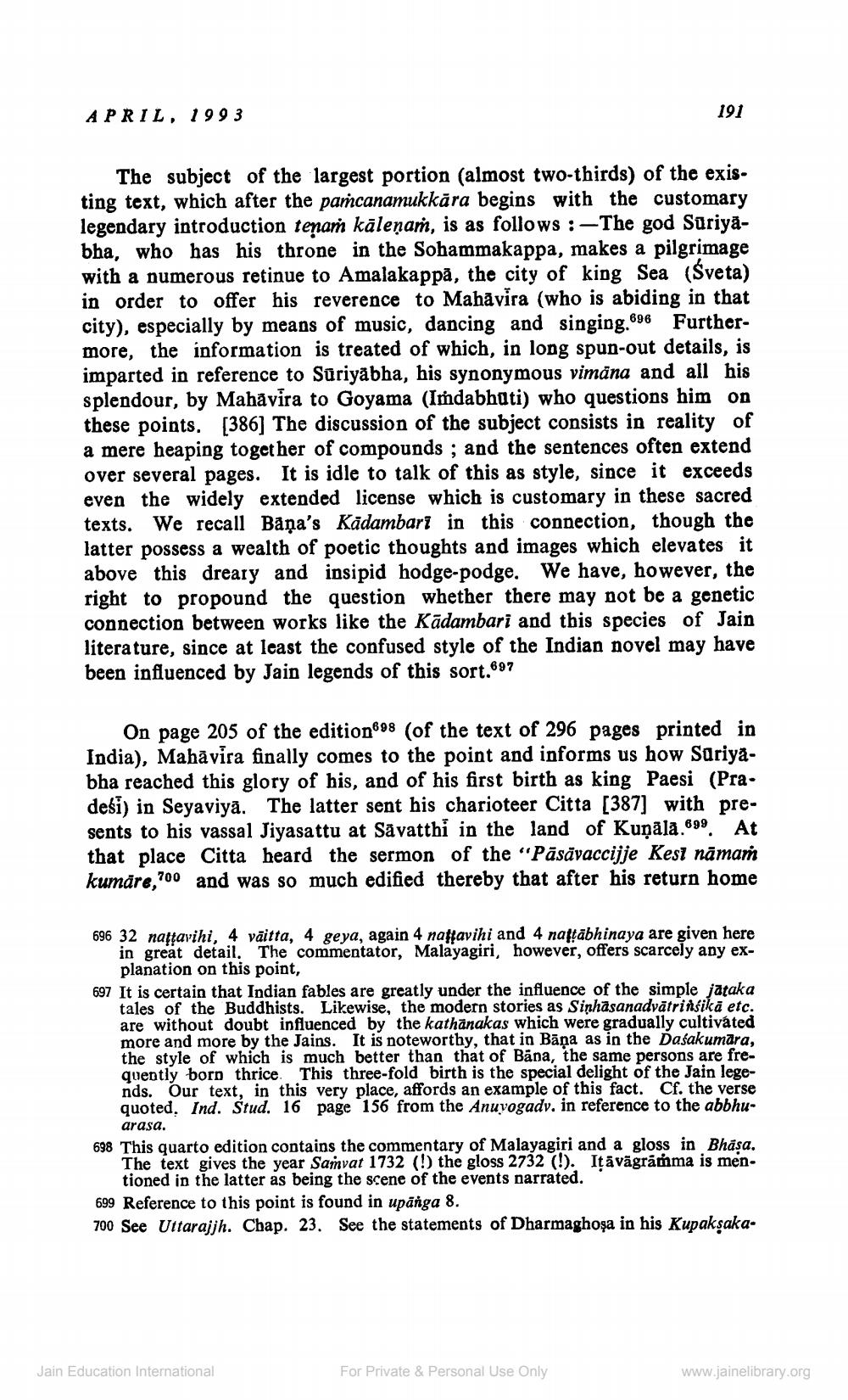________________
APRIL, 1993
The subject of the largest portion (almost two-thirds) of the existing text, which after the pamcanamukkara begins with the customary legendary introduction tenam kaleṇam, is as follows:-The god Suriyabha, who has his throne in the Sohammakappa, makes a pilgrimage with a numerous retinue to Amalakappa, the city of king Sea (Sveta) in order to offer his reverence to Mahavira (who is abiding in that city), especially by means of music, dancing and singing.696 Furthermore, the information is treated of which, in long spun-out details, is imparted in reference to Suriyabha, his synonymous vimana and all his splendour, by Mahavira to Goyama (Imdabhuti) who questions him on these points. [386] The discussion of the subject consists in reality of a mere heaping together of compounds; and the sentences often extend over several pages. It is idle to talk of this as style, since it exceeds even the widely extended license which is customary in these sacred We recall Baņa's Kadambart in this connection, though the latter possess a wealth of poetic thoughts and images which elevates it above this dreary and insipid hodge-podge. We have, however, the right to propound the question whether there may not be a genetic connection between works like the Kadambari and this species of Jain literature, since at least the confused style of the Indian novel may have been influenced by Jain legends of this sort.697
texts.
191
On page 205 of the edition698 (of the text of 296 pages printed in India), Mahavira finally comes to the point and informs us how Suriyabha reached this glory of his, and of his first birth as king Paesi (Pradesi) in Seyaviya. The latter sent his charioteer Citta [387] with presents to his vassal Jiyasattu at Savatthi in the land of Kuņāla.699. At that place Citta heard the sermon of the "Päsävaccijje Kest nāmam kumare,700 and was so much edified thereby that after his return home
696 32 nattavihi, 4 väitta, 4 geya, again 4 nattavihi and 4 natṭabhinaya are given here in great detail. The commentator, Malayagiri, however, offers scarcely any explanation on this point,
697 It is certain that Indian fables are greatly under the influence of the simple jataka tales of the Buddhists. Likewise, the modern stories as Sinhasanadvätrinsikā etc. are without doubt influenced by the kathanakas which were gradually cultivated more and more by the Jains. It is noteworthy, that in Bana as in the Dasakumara, the style of which is much better than that of Bana, the same persons are frequently born thrice. This three-fold birth is the special delight of the Jain legends. Our text, in this very place, affords an example of this fact. Cf. the verse quoted. Ind. Stud. 16 page 156 from the Anuyogadv. in reference to the abbhu
arasa.
698 This quarto edition contains the commentary of Malayagiri and a gloss in Bhașa. The text gives the year Samvat 1732 (!) the gloss 2732 (!). Itävägramma is mentioned in the latter as being the scene of the events narrated.
699 Reference to this point is found in upanga 8.
700 See Uttarajjh. Chap. 23. See the statements of Dharmaghosa in his Kupakṣaka
Jain Education International
For Private & Personal Use Only
www.jainelibrary.org




